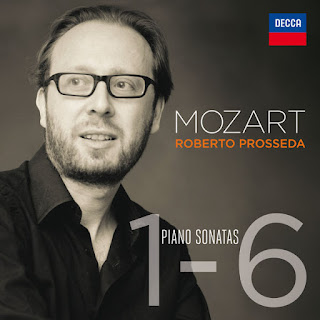 Is there really any need for yet another recording of Mozart’s sonatas?
Is it still possible to say something new when playing these
compositions while maintaining respect for the score and for the
composer’s indications? If Mozart were alive today, would he prefer to
perform his sonatas on a fortepiano of the time or on a modern piano?
Is there really any need for yet another recording of Mozart’s sonatas?
Is it still possible to say something new when playing these
compositions while maintaining respect for the score and for the
composer’s indications? If Mozart were alive today, would he prefer to
perform his sonatas on a fortepiano of the time or on a modern piano?
These are questions to which it is not possible to give an unequivocal
answer, but on which I have reflected a great deal, also profiting from
the availability of the sources and of many recent philological studies.
In the letter to his father cited earlier, written on 17 October 1777,
Mozart declared his enthusiasm for a new Stein piano that he had tried
out, which was provided with a rudimentary system for working the
dampers (corresponding to the right pedal on modern instruments).
Referring to the sonata in D he said that it “has an incomparable effect
on Stein's pianos. The pedals, pressed by the knees, are also better
made by him than by any one else; you scarcely require to touch them to
make them act, and as soon as the pressure is removed not the slightest
vibration is perceptible.” This shows Mozart’s curiosity about
innovations and his readiness to experiment with instruments that
provided greater expressive variety.
Nowadays it is possible to consult the manuscripts of the first six sonatas, currently held at the Biblioteka Jagiellońska in Kraków, and there are various critical editions that compare the manuscript version with the first published editions. On looking at the scores one is struck by the large number of original articulation marks, which we do not find so abundantly in the subsequent sonatas. I have tried, therefore, to observe the original phrase marks and dynamics attentively, even in cases in which tradition has accustomed us to softer sounds and smoother contours. It is from those phrase marks and the different kinds of staccato (dots or wedges) that one can deduce how Mozart imagined that a musical phrase should be “pronounced”. The dynamic signs, here apparently limited to forte and piano (occasionally crescendo or decrescendo, and very occasionally pianissimo), also reveal a poetic world in which contrasts are fundamental for the definition of suitable expressive variety.
Nowadays it is possible to consult the manuscripts of the first six sonatas, currently held at the Biblioteka Jagiellońska in Kraków, and there are various critical editions that compare the manuscript version with the first published editions. On looking at the scores one is struck by the large number of original articulation marks, which we do not find so abundantly in the subsequent sonatas. I have tried, therefore, to observe the original phrase marks and dynamics attentively, even in cases in which tradition has accustomed us to softer sounds and smoother contours. It is from those phrase marks and the different kinds of staccato (dots or wedges) that one can deduce how Mozart imagined that a musical phrase should be “pronounced”. The dynamic signs, here apparently limited to forte and piano (occasionally crescendo or decrescendo, and very occasionally pianissimo), also reveal a poetic world in which contrasts are fundamental for the definition of suitable expressive variety.




No hay comentarios:
Publicar un comentario